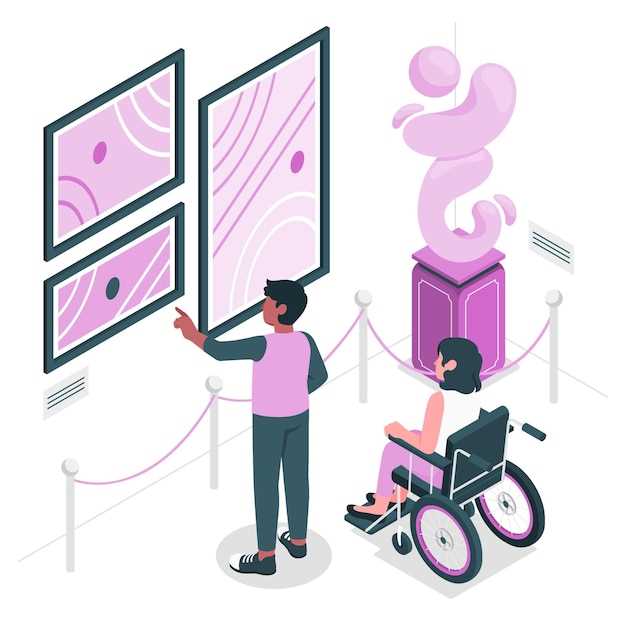
When it comes to crafting designs that cater to diverse needs and abilities, it is crucial to prioritize accessibility and inclusivity. By ensuring that built environments and digital interfaces are accessible to everyone, we can foster equal participation and provide user-friendly experiences for individuals of all backgrounds.
Designing with accessibility in mind means going beyond mere aesthetics and functionality. It involves considering the diverse range of abilities, including visual, auditory, cognitive, and physical, that individuals may possess. By acknowledging and addressing these differences, designers can create environments and interfaces that are usable and enjoyable for everyone.
Creating accessible built environments
When designing physical spaces, it is essential to consider the needs of individuals with disabilities. This includes providing ramps, elevators, and accessible entrances to ensure that individuals with mobility impairments can navigate the environment easily. Additionally, incorporating tactile cues, such as braille signage and textured surfaces, can assist individuals with visual impairments in orienting themselves within the space.
However, accessibility is not limited to physical modifications alone. It also involves creating an inclusive atmosphere that promotes social interaction and engagement. By considering the needs of individuals with cognitive disabilities, such as providing clear signage and minimizing sensory overload, designers can create environments that are welcoming and accommodating to all.
Designing inclusive digital interfaces
In today’s digital age, it is equally important to ensure that digital interfaces are accessible to individuals with disabilities. This includes designing websites and applications that are compatible with screen readers and other assistive technologies, allowing individuals with visual impairments to access and navigate digital content effortlessly.
Moreover, considering the needs of individuals with cognitive disabilities is crucial when designing digital interfaces. This involves simplifying complex information, providing clear instructions, and incorporating intuitive navigation features to enhance usability for all users.
By embracing the principles of accessibility and inclusivity in both built environments and digital interfaces, designers can create designs that empower individuals, promote equal participation, and provide user-friendly experiences for everyone. Through thoughtful consideration of diverse abilities and needs, we can foster a more inclusive society where everyone can thrive and engage fully.
Understanding the Importance of Accessibility
Recognizing the significance of accessibility is crucial in creating inclusive environments and interfaces that cater to the diverse needs of individuals. By prioritizing accessibility, we ensure that everyone, regardless of their abilities or disabilities, can fully participate and engage in various aspects of life.
Accessibility goes beyond mere compliance with regulations; it is about fostering equal opportunities and promoting inclusivity. It involves designing spaces and digital platforms that are usable, convenient, and accommodating for individuals with different physical, sensory, and cognitive abilities.
When we embrace accessibility, we acknowledge that everyone deserves equal access to information, services, and opportunities. It allows individuals with disabilities to navigate physical spaces, interact with digital interfaces, and participate in society on an equal footing with their peers.
- Accessibility empowers individuals with disabilities by removing barriers and enabling independence.
- It enhances user experiences for all individuals, regardless of their abilities.
- Accessible design promotes diversity and inclusivity, fostering a more equitable society.
- It ensures compliance with legal requirements and accessibility standards.
- By considering accessibility from the outset, we save time and resources in retrofitting inaccessible environments or interfaces.
Ultimately, understanding the importance of accessibility is about recognizing the inherent value of every individual and striving to create environments and interfaces that are welcoming, inclusive, and empowering for all.
Key Principles for Creating Accessible Built Environments

In order to ensure inclusivity and equal access for all individuals, it is essential to consider key principles when designing built environments. By incorporating these principles, designers can create spaces that are welcoming, functional, and accommodating to diverse needs.
1. Universal Design
Universal design is a fundamental principle that emphasizes the creation of environments that can be used by people of all abilities, ages, and backgrounds. By considering the needs of a wide range of users, designers can develop spaces that are accessible and inclusive.
2. Clear and Intuitive Navigation
Clear and intuitive navigation is crucial in ensuring that individuals can easily move through a built environment. This includes providing clear signage, well-defined pathways, and accessible entrances and exits. Designers should also consider the use of tactile cues and visual indicators to assist individuals with visual impairments.
3. Adequate Space and Layout
Providing adequate space and thoughtful layout is essential for accommodating individuals with mobility devices, such as wheelchairs or walkers. Designers should ensure that doorways, hallways, and maneuvering areas are wide enough to allow for easy passage. Additionally, furniture and fixtures should be arranged in a way that allows for comfortable and convenient use.
4. Inclusive Communication
Effective communication is key to creating an inclusive environment. Designers should consider incorporating multiple modes of communication, such as visual, auditory, and tactile, to ensure that information is accessible to all individuals. This may include the use of braille signage, captioning for videos, and hearing loop systems.
5. Sensory Considerations
Sensory considerations play a crucial role in designing for accessibility. Designers should be mindful of factors such as lighting, acoustics, and color contrast to create environments that are comfortable and accommodating for individuals with sensory sensitivities or impairments.
- Provide appropriate lighting levels to ensure visibility without causing glare or discomfort.
- Consider acoustics to minimize background noise and echo, ensuring clear communication.
- Use color contrast to enhance visibility and aid individuals with visual impairments.
By adhering to these key principles, designers can contribute to the creation of built environments that are accessible, inclusive, and welcoming to all individuals, regardless of their abilities or disabilities.
Creating Inclusive Digital Interfaces: Best Practices
In today’s rapidly evolving digital landscape, it is crucial to ensure that digital interfaces are designed with inclusivity in mind. By adopting best practices, we can create digital experiences that cater to the diverse needs of users, regardless of their abilities or limitations. This section explores key strategies and principles for designing inclusive digital interfaces, promoting equal access and usability for all.
1. Prioritize User-Centric Design
When designing digital interfaces, it is essential to prioritize the needs and preferences of the users. Conduct thorough user research to gain insights into the diverse range of abilities, disabilities, and user contexts. By understanding the unique challenges faced by different users, we can create interfaces that are intuitive, efficient, and accessible to all.
2. Ensure Clear and Consistent Communication

Effective communication is at the core of inclusive design. Use clear and concise language, avoiding jargon or technical terms that may be unfamiliar to some users. Provide instructions, feedback, and error messages in a way that is easily understandable and actionable. Consistency in design elements, such as icons, buttons, and navigation, helps users navigate the interface confidently and reduces cognitive load.
By implementing these best practices, designers can contribute to a more inclusive digital landscape, where everyone can access and engage with digital interfaces seamlessly. Creating inclusive digital interfaces not only benefits individuals with disabilities but also enhances the overall user experience for all users, promoting equal opportunities and inclusivity in the digital realm.
The Role of Technology in Enhancing Accessibility
Advancements in technology have played a pivotal role in improving accessibility across various domains. This section explores the significant impact of technology in creating inclusive environments and interfaces, ensuring equal opportunities for individuals with diverse abilities.
Breaking Barriers through Assistive Technologies
Assistive technologies have revolutionized the way individuals with disabilities interact with their surroundings. These innovative tools and devices empower people with visual, auditory, cognitive, or physical impairments to overcome barriers and actively participate in society. From screen readers and braille displays to speech recognition software and alternative input devices, assistive technologies have opened up new possibilities for communication, education, and employment.
Advancing Digital Accessibility
In the digital realm, technology has paved the way for enhanced accessibility in websites, applications, and digital interfaces. Through the implementation of inclusive design principles and the utilization of assistive technologies, digital platforms can be made accessible to a wider audience. This includes features such as alternative text for images, captions and transcripts for videos, keyboard navigation options, and adjustable font sizes and color contrasts. By prioritizing digital accessibility, organizations can ensure that their online presence is inclusive and welcoming to all users.
| Benefits of Technological Accessibility | Challenges and Future Considerations |
|---|---|
| 1. Increased independence and autonomy for individuals with disabilities. | 1. The need for ongoing research and development to address evolving accessibility requirements. |
| 2. Improved educational opportunities and access to information. | 2. Ensuring affordability and availability of assistive technologies for all individuals. |
| 3. Enhanced social inclusion and participation in various aspects of life. | 3. Addressing the digital divide and ensuring equitable access to technology. |
Overall, technology has emerged as a powerful tool in promoting accessibility and inclusivity. By leveraging the potential of technology, we can continue to break down barriers and create a more inclusive society for everyone.
Overcoming Challenges in Designing for Accessibility
Addressing the obstacles that arise when creating inclusive experiences for individuals with diverse needs and abilities is a crucial aspect of designing for accessibility. This section explores the various difficulties encountered during the process, highlighting the importance of finding innovative solutions.
1. Surmounting Barriers: One of the primary challenges in ensuring accessibility is identifying and overcoming the barriers that hinder individuals from fully engaging with built environments and digital interfaces. These barriers can be physical, such as architectural obstacles or lack of assistive technologies, or they can be digital, such as inaccessible website designs or non-compliant software.
2. Promoting Awareness: Another significant challenge lies in raising awareness about the importance of accessibility among designers, developers, and stakeholders. It is crucial to educate and advocate for inclusive design practices to ensure that accessibility is considered from the outset of any project. This requires fostering a culture of inclusivity and encouraging collaboration between different disciplines.
3. Adapting to Diverse Needs: Designing for accessibility involves catering to a wide range of diverse needs and abilities. This can be challenging as individuals may have varying levels of visual, auditory, cognitive, or physical impairments. Designers must consider these differences and develop solutions that accommodate everyone, ensuring equal access and usability for all users.
4. Keeping Up with Technological Advancements: As technology continues to evolve rapidly, designers face the challenge of keeping up with the latest advancements and incorporating them into accessible design practices. Staying informed about emerging technologies and understanding how they can be leveraged to enhance accessibility is crucial for creating inclusive experiences.
5. Balancing Aesthetics and Accessibility: Designers often encounter the challenge of striking a balance between aesthetics and accessibility. While it is essential to create visually appealing designs, it should not come at the expense of accessibility. Finding creative ways to integrate inclusive design principles without compromising the overall aesthetic appeal is a constant challenge.
In conclusion, designing for accessibility involves overcoming various challenges, including surmounting barriers, promoting awareness, adapting to diverse needs, keeping up with technological advancements, and balancing aesthetics and accessibility. By addressing these challenges head-on, designers can create inclusive experiences that empower individuals of all abilities.
The Future of Accessibility: Innovations and Trends
In this section, we explore the upcoming advancements and emerging trends in creating inclusive environments and digital interfaces. As society becomes more aware of the importance of accessibility, designers and innovators are continuously pushing the boundaries to ensure equal access for all individuals, regardless of their abilities or disabilities.
Advancements in Assistive Technologies
One of the key areas driving the future of accessibility is the development of advanced assistive technologies. These technologies aim to enhance the independence and quality of life for individuals with disabilities. From wearable devices that provide real-time feedback and support to smart home systems that can be controlled through voice commands, the possibilities are expanding rapidly. Innovations such as brain-computer interfaces and haptic feedback systems are also paving the way for new ways of interaction and communication.
Inclusive Design Principles
Another significant trend in the future of accessibility is the adoption of inclusive design principles. Designers are recognizing the importance of considering diverse user needs from the outset, rather than retrofitting solutions later. Inclusive design goes beyond accommodating disabilities and focuses on creating products and environments that can be used by everyone, regardless of age, language, or cognitive abilities. By incorporating universal design principles, designers can ensure that their creations are accessible to the widest possible audience.
As we move forward, it is crucial for designers, architects, and technologists to stay informed about these innovations and trends. By embracing the future of accessibility, we can create a more inclusive and equitable society for all individuals.